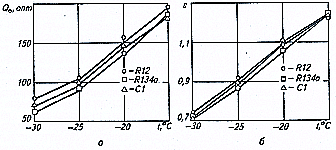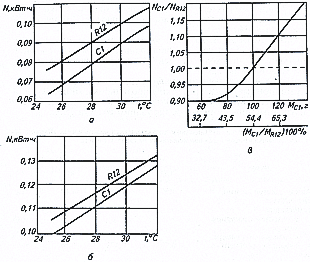

| NEWS | |||||||
| ABOUT | |||||||
| PRODUCTS AND SERVICES | |||||||
|
| |||||||
| PLACE AN ORDER | |||||||
| DOWNLOAD | |||||||
| HELPFUL HINTS | |||||||
| FAQ | |||||||
| LINKS | |||||||
| SEARCH | |||||||
| SITE MAP | |||||||
| CONTACT | |||||||
| русский |
Alternative multi-component refrigerants on the base of hydrocarbonsС1 refrigerant. As a result of complex research in the Keldish Research Institute of Thermal Processes (Russia), there has been developed a number of multi-component ozone- safe refrigerants instead of R134a as an alternative to R12. The most perspective of them is C1 refrigerant (azeotrope blend R152/R600a), which is the blend of hydrocarbons and fluorocarbons. The results of the research indicate high thermalphysic and operational qualities of the refrigerants and low energy consumption of refrigerants where these refrigerants are used. Dependence of cold-productivity and refrigerating factor on boiling point for C1, as well as for R12 и R134a, is given on Fig. down. Experimentation showed that cold-productivity and refrigerating factor of XKB-6 and V1040G compressors, filled with C1 blend, within the range of boiling points peculiar for domestic refrigerators and deep-freezers, correspond to analogous parameters for R12 and particularly for R134a.
Comparative tests of refrigerants "Biryusa-22" and deep-freezers "Biryusa-14", operating on different refrigerants, showed that the change for С1 blend resulted in 2,5...8,7 % dropping of power requirement. In the table there are given comparative energy and operation indicators of the deep-freezer "Biryusa-14" and the refrigerant "Biryusa-22", operating on С1 and R12 refrigerants, obtained at outdoor air temperature 25 oС
Energy consumption of foreign refrigerators at their test with C1 blend is given on Fig. down. After R12 substitution with C1 blend, energy consumption of the domestic refrigerator АР807 was reduced by 16,9 %, and that of refrigerator АР716 - by 5,16 %. Experimental data obtained in the USA during testing of the foreign refrigerator with C1 blend showed that under optimal charging dose, its energy consumption is 10% less, then under operating of this refrigerator on R12 (Fig., B).
However, fire risk and explosive risk of С1 refrigerant make its use for operative stock of refrigerating equipment problematic. One has to take into account also that in the operational range of temperatures, C1 azeotrope blends change their concentration by 3...6% which impedes the procedure of a refrigerating aggregate filling, topping-up and re-filling with the refrigerant. In Russia in 1995 there has been manufactured on the refrigerator factory "Biryusa" the pilot lot of 100 refrigerators with serial hermetic compressor on hydrocarbon blend C1. Propane-butane blend. According to the results of the research, it is suggested to use also propane-butane blend as a refrigerant in domestic refrigerators: but at that alterations to the domestic refrigerator design are not entered, and usual mineral oils operating with R12 are used. For the period of operation of domestic refrigerators, during 5 years there have not been observed any change bits of a refrigerant and oil. In the table there are given operation performance of TS135 and TS175 domestic refrigerators (Poland) with the volume correspondingly 135 and 175 dm3.
As to energy characteristics of the theoretical refrigeration cycle, propane-butane cycle under analogous conditions is inferior to R12. In Germany for several years already there have been manufactured by small lots refrigerators operating on this blend. Propane-butane blend is zeotrope. As it has been stated before, such blends boil under variable temperatures but constant pressure, that is, this quality can be realized in refrigerators with two evaporators when boiling of zeotrope blend starts in low-temperature compartment, and boil-off occurs in the evaporator of a refrigeration chamber at higher temperatures. Suggested propane-isobutane blend (43 % R600a) is combustible, but mass of a refrigerant in a domestic refrigerator is small (20...40 gm). This blend is used to charge domestic refrigerators in Germany, it is widely introduced in China and India. At the same time, the American Environment Protection Agency (ЕРА) introduced a rule prohibiting the use of propane-isobutane blend (НС-12а) as an alternative to R12. СМ1 refrigerant. This refrigerant has been developed in IEI (composition R134a/R218/R600), it is zeotrope, fire-safe and explosion-safe blend, close to R12 according to thermodynamic characteristics and soluble in mineral oils. Alteration of refrigerating machine design, application of new lubricating oils and production reequipment are not required. In the table there are given comparative results of testing of domestic refrigerators "ZIL", "Mir-101", "Oka-6М" and deep-freezer "Sviyaga-106".
As the testing showed, СМ1 refrigerant can be used in domestic refrigerators instead of R12. Daily energy consumption in domestic refrigerators charged with СМ1, is 4...9% higher, than in refrigerators operating on R12. In order to increase energy effectiveness, it is recommended to ensure valid regenerative heat transfer in refrigerating aggregates (between liquid and absorbable refrigerant currents). СМ1 refrigerant is also suggested to use in commercial and industrial refrigerating equipment manufactured at the moment for operation on R12, as well as for retrophite of a part of the operative stock of refrigerating machines. Exemplary demand of СМ1 refrigerant (in the new production and at retrophite) in 2000.:
At the same time, along with available source of raw materials, production of CM1 refrigerant has not been yet organized. | |||||||||||||||||||||||||||||||||||||||||||||||||||||||||||||||||||||||||||||||||||||||||||||||||

 Research carried out in the Keldish Research Institute of Thermal Processes allowed to come to the following conclusions:
Research carried out in the Keldish Research Institute of Thermal Processes allowed to come to the following conclusions: